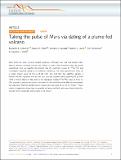Taking the pulse of Mars via dating of a plume-fed volcano
Abstract
Mars hosts the solar system's largest volcanoes. Although their size and impact crater density indicate continued activity over billions of years, their formation rates are poorly understood. Here we quantify the growth rate of a Martian volcano by 40Ar/39Ar and cosmogenic exposure dating of six nakhlites, meteorites that were ejected from Mars by a single impact event at 10.7 ± 0.8 Ma (2σ). We find that the nakhlites sample a layered volcanic sequence with at least four discrete eruptive events spanning 93 ± 12 Ma (1416 ± 7 Ma to 1322 ± 10 Ma (2σ)). A non-radiogenic trapped 40Ar/36Ar value of 1511 ± 74 (2σ) provides a precise and robust constraint for the mid-Amazonian Martian atmosphere. Our data show that the nakhlite-source volcano grew at a rate of ca. 0.4-0.7 m Ma-1-three orders of magnitude slower than comparable volcanoes on Earth, and necessitating that Mars was far more volcanically active earlier in its history.
Citation
Cohen , B E , Mark , D F , Cassata , W S , Lee , M R , Tomkinson , T & Smith , C L 2017 , ' Taking the pulse of Mars via dating of a plume-fed volcano ' , Nature Communications , vol. 8 , 640 . https://doi.org/10.1038/s41467-017-00513-8
Publication
Nature Communications
Status
Peer reviewed
ISSN
2041-1723Type
Journal article
Description
This work was funded by the Science and Technology Facilities Council (grants ST/H002472/1, ST/H002960/1 and ST/K000918/1 to D.F.M. and M.R.L.) and the NASA Mars Fundamental Research Program (grant NNH14AX56I to W.S.C.). Portions of this work were performed under the auspices of the U.S. Department of Energy by Lawrence Livermore National Laboratory under Contract DE-AC52-07NA27344.Collections
Items in the St Andrews Research Repository are protected by copyright, with all rights reserved, unless otherwise indicated.

